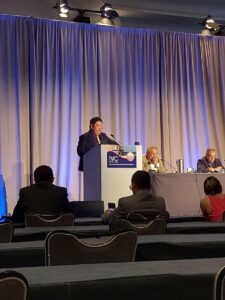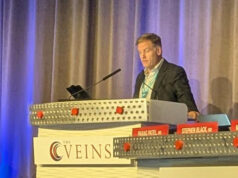
On the final day of the 2024 International Vein Congress (April 18–20) in Miami, Florida, Joseph P. Hart, MD, associate professor of surgery and radiology at Medical College of Wisconsin in Milwaukee, Wisconsin, Andrea P. Munive-Gnecco, MD, from Bogotá, Colombia, Luis E. Londoño-Mejía, MD, also from Bogotá, Colombia, Nuttawut Sermsathanasawadi, MD, from Bangkok, Thailand, Juan Cabrera Garcia-Olmedo, MD, from Grenada, Spain, and Suandaram Ravikumar, MD, from Dobbs Ferry, New York, each presented abstracts focusing on venous and lymphatics set for submission to the Journal of Vascular Surgery-Venous and Lymphatic Disorders (JVS-VL). Each presentation was then critiqued by one of the attending vascular surgeons.
Hart’s study focused on the current outcomes of interventions to treat mixed arterial-venous ulcers. Hart and his team looked at the outcomes of ulcer healing on about 1,100 patients at 24 weeks, and then a second follow-up at one year.
“Isolated venous ulcer was defined as the presence of a venous ulcer with a normal TBI [toe brachial index], or toe pressure greater than 60,” Hart told the audience via video conference. “Mixed was defined as a venous ulcer in the presence of an abnormal TBI or the toe pressure was less than 60.”
Hart and his team found that combined arterial-venous and arterial interventions accelerate wound heling times when compared to venous interventions alone. This leads to decreased ulcer recurrence and improved long-term limb-based events in mixed ulcers.
The second abstract, from Munive-Gnecco and her team, focused on the outcomes of varicectomies in Colombia, a sub-analysis of the Colombian Surgical Outcomes Study (ColSOS).
“In low- and middle-income countries like Colombia, primary data on surgical procedures is scarce,” Munive-Gnecco told the audience. She and her team looked at nearly 4,000 patients who were over the age of 18 receiving varicectomies, limb amputations, and other vascular procedures in different institutions across the country.
The study concluded that the secondary data from the current database, which is from 2015, underestimated the real burden in perioperative mortality across patients. It also became apparent that the procedures being looked at in this study are not directly comparable, which means that drawing conclusions based on the crude data may not be conducive to informed public health decisions, the investigators reported.
“The intricate interplay of factors influencing outcomes in vascular surgery necessitates a nuanced understanding,” Munive-Gnecco stated. “Efforts should be directed towards refining analyses that consider the unique characteristics of each procedure.”
The third abstract, from Londoño-Mejía and his team, looked at gonadal vein embolization in pelvic congestion syndrome—a Latin-American center experience.
Londoño-Mejía and his team performed a single-center, retrospective case series study looking at patients who underwent coil embolization between 2019 and 2023.
Londoño-Mejía began by explaining that, in their research, the prevalence of pelvic congestion syndrome is up 30-40% in patients who suffer from chronic pelvic pain. He also explained that, since this study was done in Colombia, a low- to middle-income country, there is difficulty in access to surgery and challenges in consistent follow-up post-procedure.
Londoño-Mejía concluded by stating that coil embolization results in successful improvement of patient symptoms, although objective measurements are needed in future research. More robust studies are necessary, including direct comparisons between different techniques, he added.
The fourth abstract, presented by Sermsathanasawadi, focused on the effectiveness of early cyanoacrylate closure and compression therapy alone in the healing of venous leg ulcers caused by superficial vein reflux in a randomized controlled trial. Sermsathanasawadi’s presentation won a monetary prize along with a JVS plaque.
Sermsathanasawadi and his team defined the primary outcome for this study as complete re-epithelialization of all ulcers on the leg with no dressing required. Ulcer wound size was evaluated every four weeks until the 24-week mark.
The study concluded that the rate of ulcer healing at 24 weeks was comparable between compression therapy alone and compression with cyanoacrylate glue; that cyanoacrylate glue had a higher rate of ulcer healing at 50 days than the compression only group; and that continued compression therapy with the early use of cyanoacrylate glue improves healing of venous leg ulcers.
The fifth abstract, from Garcia-Olmedo and his team, looked at innovations in nitrogen-free pharmaceutical foams for universal sclerotherapy.
“Historically, foams have been considered statistical collections of bubbles,” Garcia-Olmedo told the audience. “This paradigm leads to the perception that you can interact with one bubble without changing the rest of the arrangement.”
Garcia-Olmedo and his team used mathematical computer models to see real-time analyses of how the foams act. The foam will, unless each bubble is identically sized, destabilize and combine into progressively larger bubbles. When this happens, the foam can move away from where it was meant to be placed.
The study determined that it is not possible for the foam bubbles to be identically sized, though ultrasound guided sclerotherapy with foam is still a good treatment option.
The sixth and final abstract was presented by Ravikumar and focused on a paradigm shift in treating venous leg ulcers. Ravikumar and his team created a compression system, called AeroCare, that looks to solve venous leg ulcer issues.
The AeroCare device is measurable, adjustable, and can keep consistent pressure over the course of multiple days, he said. This helps to ensure that, for patients who have limited access to healthcare options, the device is effective without too much physician intervention. Patients who received treatment from the AeroCare device were seen once a week until the ulcer had healed completely.
Device limitations include requiring appropriate training in technique for the application of AeroCare, which can be time consuming, Ravikumar pointed out. Furthermore, it is not adjustable, and there can be some degradation of pressure over time, he added. “Some patients have also reported discomfort, pain, and odor when using the device.”
Ravikumar stated that patients who used the AeroCare device consistently and correctly all had their leg ulcers heal within seven weeks. He concluded by saying that the AeroCare system provides a potentially more convenient way to treat VLU.








